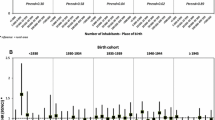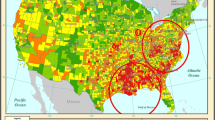Abstract
The long-term trend of female breast cancer incidence rates in the United States and some European countries demonstrates a similar pattern: an increasing trend in the last century followed by a declining trend in this century. The well-known risk factors cannot explain this trend. We compared the breast cancer incidence trends obtained from SEER data with the trend of nitrogen dioxides (NOx) emission and monitoring data as well as motor vehicle density data. The upward followed by downward trend of NOx is similar to the breast cancer incidence trend but with an offset of 20 years earlier. Motor vehicles are the major source of NOx emissions. The geographic distribution of motor vehicles density in 1970 in the observed US counties is positively correlated with breast cancer incidence rates (R 2 0.8418, the correlation coefficient = 0.9175) in 1980–1995. Because both the time trend and geographic pattern are associated with breast cancer incidence rates, further studies on the relationship between breast cancer and air pollution are needed.




Similar content being viewed by others
References
American Cancer Society (2011) Cancer Facts and Figures 2011. http://www.cancer.org/acs/groups/content/@epidemiologysurveilance/documents/document/acspc-029771.pdf. Accessed 11 Oct 2011
Huang CS, Chang KJ, Shen CY (2001) Breast cancer screening in Taiwan and China. Breast Disease 13:41–48. http://iospress.metapress.com/content/y1nlkyxtf7w2jdp3/. Accessed on 18 Oct 2011
Chen F, Cole P, Bina W (2007) Time trend and geographic patterns of lung adenocarcinoma in the U.S., 1972–2002. Cancer Epidemiol Biomarkers Prev 16(12):2724–2729
Chen F, Jackson H, Bina W (2009) Lung adenocarcinoma incidence rates and their relation to motor vehicle density. Cancer Epidemiol Biomarkers Prev 18(3):760–764
EPA (2000) National air pollutant emission trends, 1900–1998. EPA-454/R-00-002. 2000. p. 3–19 to 20
EPA (2011) National trends in nitrogen dioxide levels. http://www.epa.gov/airtrends/nitrogen.html. Accessed 2 Aug 2011
Collaborative Group on hormonal Factors in Breast Cancer (1997) Breast cancer and hormone replacement therapy: collaborative reanalysis of data from 51 epidemiological studies of 52, 705 women with breast cancer and 108, 411 women without breast cancer. Lancet 350:1047–1059
Hunter DJ, Spiegelman D, Adami H-O et al (1997) Non-dietary factors as risk factors for breast cancer, and as effect modifiers of the association of fat intake and risk of breast cancer. Cancer Causes Control 8:49–56
Layde PM, Webster LA, Baughman AL et al (1989) The independent associations of parity, age at first full term pregnancy, and duration of breast feeding with the risk of breast cancer. J Clin Epimemiol 42:963–973
Ewertz M, Duffy S, Adami H-O et al (1990) Age at first birth, parity and risk o f breast cancer: a meta-analysis of 8 studies from Nordic countries. Int J Cancer 46:597–603
Ford D, Easton DF, Stratton M et al (1998) Genetic heterogeneity and penetrance analysis of the BRCA1 and BRCA2 genes in breast cancer families. The breast cancer linkage consortium. Am J Hum Genet 63(3):676–689
Chen S, Parmigiani G (2007) Meta-analysis of BRCA1 and BRCA2 penetrance. J Clin Oncol 25:1329–1333
National Cancer Institute (2009) Genetics of Breast and Ovarian Cancer (PDQ). http://www.cancer.gov/cancertopics/pdq/genetics/brest-and-ovarian/healthprofessional. Accessed 14 May 2009
Hunter DJ, Spiegelman D, Adami H-O et al (1996) Cohort studies of fat intake and the risk of breast cancer—a pooled analysis. N Engl J Med 334:356–361
Gandini S, Merzenich H, Robertson C et al (2000) Meta-analysis of studies on breast cancer risk and diet: the role of fruit and vegetable consumption and the intake of associated micronutrients. Dur J Cancer 36:636–646
Friedenreich CM, Thune I, Brinton LA et al (1998) Epidemiologic issues related to the association between physical activity and breast cancer. Cancer 83:600–610
Luo J, Margolis KL, Wactawski-Wende J et al (2011) Association of active and passive smoking with risk of breast cancer among postmenopausal women: a prospective cohort study. BMI 342:d1016. doi:10:1136/bmi.d1016
Hunter DJ, Colditz GA, Hnakinson SE, Malspeis S, Spiegelman D, Chen W, Stampfer MJ, Willett WC (2010) Oral contraceptive use and breast cancer: a prospective study of young women. Cancer Epidemiol Biomarkers Prev 19(10):2496–2502
Howell A, Evans GD (2011) Hormone replacement therapy and breast cancer. In: Semm JK, Pttp F (eds) Clinical cancer prevention, recent results in cancer research, vol 188. Springer-Verlag, Berlin. doi: 10.1007/978-3-642-10858-7_10
Rossouw JE, Anderson GL, Prentice RL, LaCroix AZ, Kooperberg C, Stefanick ML et al (2002) Risks and benefits of estrogen plus progestin in healthy postmenopausal women: principal results from the Women’s Health Initiative randomized controlled trial. JAMA 288:321–333
Crouse DL, Goldberg MS, Ross NA, Chen H, Labrehe F (2011) Postmenopausal breast cancer is associated with exposure to traffic-related air pollution in Montreal, Canada: a case-control study. Environ Health Perspect 118:1578–1583
Baker L (2011) Air pollution exposure linked to premenopausal breast cancer University of Buffalo Reporter. http://www.buffalo.edu/ubreporter/2011_04_28/pollution_breast_cancer. Accessed 4 Aug 2011
Mordan LJ, Burnett TS, Zhang LX, Tom J, Cooney RV et al (1993) Inhibitors of endogenous nitrogen oxide formation block the promotion of neoplastic transformation in C3H 10T1/2 fibroblasts. Carcinogenesis 14(8):1555–1559
Wink DA, Laval J (1994) The Fpg protein, a DNA repair enzyme, is inhibited by the biomediator nitric oxide in vitro and in vivo. Carcinogenesis 15:2125–2129
Jenkins DC, Charles IG, Thomsen LL, Moss DW, Holmes LS, Baylis SA et al (1995) Roles of nitric oxide in tumor growth. Proc Natl Acad Sci USA 92:4392–4396
Conflict of interest
Dr. Chen and Dr. Bina have no conflict of interest.
Author information
Authors and Affiliations
Corresponding author
Rights and permissions
About this article
Cite this article
Chen, F., Bina, W.F. Correlation of white female breast cancer incidence trends with nitrogen dioxide emission levels and motor vehicle density patterns. Breast Cancer Res Treat 132, 327–333 (2012). https://doi.org/10.1007/s10549-011-1861-z
Received:
Accepted:
Published:
Issue Date:
DOI: https://doi.org/10.1007/s10549-011-1861-z




